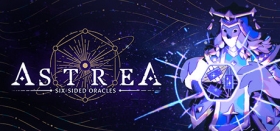
Astrea: Six Sided Oracles Review
Astrea: Six Sided Oracles is a deck-building roguelike with noticeable inspiration from Slay The Spire. Despite this inspiration, however, it manages to hold its own incredibly well, even going so far as potentially being one of my favourite deck-builders of all time.
The plot begins strong yet takes a point of being primarily for worldbuilding, at least early on. It does a fantastic job of setting things in motion, explaining the characters and their motives for being there, and does a good job meshing with the gameplay mechanics. The world used to be pure, yet after a sudden and mysterious corruption spread, causing galactic devastation and killing off the Oracles — people chosen by the Stars to protect the world from corruption. Years later, descendants of the Oracles come together to end the corruption for good.
At the start of each run, you choose an Oracle, which determines your starting deck of Dice, along with your Virtues and sometimes even Blessings, all of which define each Oracle's playstyle. Combat encounters are where the majority of the game takes place. Throughout the levels, you’ll add Dice to your deck, all of which have different abilities on each face. Some are high risk, others are low risk. But the payoff on higher-risk dice is much higher. Players draw a set amount of dice at the beginning of each fight, dependent on certain abilities. These Dice are rolled, and these make up your hand for the turn. Dice can be played on each turn, whilesome Dice must be played to to end your turn. Oftentimes, these are negative Dice, which requires some interesting thinking in terms of the order in which you play them.

The gameplay takes these prime players in the story and works them into the basic gameplay loop, having to balance both Purify and Corruption. Purify heals the Oracles and damages corrupt beings, while Corruption does the opposite. The player has a purity metre, which, when being corrupted, decreases and, when it hits zero, takes a heart away and refills with purity. When the player loses all of their hearts, they die. However, corruption isn’t always a bad thing; as the player gets corrupt, they gain access to their virtues,: special abilities which can be used regardless of the Dice rolled. On the topic of Dice, they are your main method of doing anything in combat, whether that is purifying yourself or enemies, applying buffs and debuffs, or other unique mechanics, which differ depending on which of the six Oracles you play. However, Dice can also roll negative effects, such as corruption, which have to be played before the turn ends, leading to an incredible amount of choice. Risk/reward is a huge part of this game, which makes winning a run feel incredibly satisfying. The different Oracles all push highly unique play-styles, and all feel very viable when played well. For example, Hevelius highly emphasises the use of Sentinels — robots which can be bought occasionally from shops that all have a special Dice — yet Hevelius starts with two random Sentinels, and has many Dice focusing on them. Boss fights are a wonder in Astrea; each boss is incredibly interesting and unique and all have obvious strengths and weaknesses. Due to the Corruption / Purify system, each fight has to be taken on in very different ways, yet they never felt unfair. In other roguelikes of a similar style, I often felt my builds were just incompatible with the bosses and made them incredibly tedious, so the varied play-styles, even with a single build, allows for each boss to be interesting no matter your choice.

Meta-progression is done perfectly, which is a difficult balance to strike in roguelikes. Each Oracle has an XP system, and as they level up, they unlock not only new Dice and Dice effects, but also new blessings. Blessings give passive effects and are either Black Hole Blessings or Star Blessings. Black Hole Blessings have incredibly strong effects, yet also give negative ones, making them a risky choice. Star Blessings are much safer but also weaker. Later Oracles also need to be unlocked via levelling up the previous Oracles, along with having to beat the game at least once on each character to unlock the final Oracle and what seems to be a true ending. In a similar fashion to Slay the Spire’s ascension system, each time you beat the game, you will unlock a new anomaly level, which increases the difficulty, yet increases the XP gain. Looking at the compendium shows that, as of right now, there are 750 Dice and 175 Blessings, so the replay value is absolutely here.
I would be missing out on the game's greatest assets by ignoring its absolutely gorgeous presentation. Its visual style is incredibly standout and looks utterly beautiful. Oracles all have interesting and unique designs, while the environments serve to be fantastic backdrops for such a wonderful world. Sound design also blew me away. The music especially was beautiful and gave me very similar vibes to the Kingdom Hearts series, which is the highest form of flattery I can bestow upon a soundtrack.
Overall, Astrea: Six Sided Oracles is one of the greatest deck-builders I have ever come across, not only is the presentation absolutely insane. But the gameplay is unendingly satisfying, having the replayability a roguelike needs to stay in the limelight. Aside from some issues with the RNG element of the Dice rolling system, it’s a near-flawless title.
Astrea: Six-Sided Oracles (Reviewed on Windows)
Excellent. Look out for this one.
Astrea: The Six Sided Oracles is an absolute masterclass in both roguelike and deck-building and looks to be a mainstay in the genre









COMMENTS